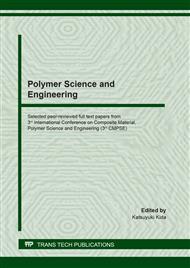[1]
S. Hiermaier and T. Meenken, Characterization of low-impedence materials at elevated strain rates,, J Strain Analysis, vol. 45, pp.401-409, (2010).
DOI: 10.1243/03093247jsa584
Google Scholar
[2]
R. Gerlach, C. Siviour, J. Wiegand and N. Petrinic, The strain rate dependent material behaviour of S-GFRP extracted from GLARE,, Mech Adv Mater Struct, pp.505-514, (2012).
DOI: 10.1080/15376494.2011.627646
Google Scholar
[3]
M. Isakov, J. Lange, S. Kilchert and M. May, In-situ damage evaluation of pure ice under high-rate compressive loading,, Materials, vol. 12, no. 8, p.1236, (2019).
DOI: 10.3390/ma12081236
Google Scholar
[4]
G. Jacob, J. Starbuck, J. Fellers, S. Simunovic and R. Boeman, The Effect of Loading Rate on the Fracture Toughness of Fiber Reinforced Polymer Composites,, J Appl Polym Sci, pp.899-904, (2005).
DOI: 10.1002/app.21535
Google Scholar
[5]
M. May, Measuring the rate-dependent mode I fracture toughness of composites – A review,, Compos Part A - Appl S, pp.1-12, (2016).
Google Scholar
[6]
M. May and T. Lässig, Rate-dependent mode I delamination in ballistic composites - Experiment and simulation,, Composite Structures, vol. 180, pp.596-605, (2017).
DOI: 10.1016/j.compstruct.2017.08.045
Google Scholar
[7]
M. May and O. Hesebeck, Assessment of experimental methods for calibrating rate-dependent cohesive zone models for predicting failure in adhesively bonded metallic structures,, Eng Fail Anal, pp.441-453, (2015).
DOI: 10.1016/j.engfailanal.2014.12.008
Google Scholar
[8]
H. Paul, N. Ledford, M. Sauer, M. May and M. Okamura, Assessment of test methods for thick and thin layer adhesive joints under high rates of loading,, Int J Adhes Adhes, vol. 83, pp.123-129, (2018).
DOI: 10.1016/j.ijadhadh.2018.02.025
Google Scholar
[9]
P. Jousset and M. Rachik, Comparison and evaluation of two types of cohesive zonemodels for the finite element analysis of fracture propagationin industrial bonded structures,, Eng Fract Mech, vol. 132, pp.48-69, (2014).
DOI: 10.1016/j.engfracmech.2014.10.018
Google Scholar
[10]
M. May, O. Hesebeck, S. Marzi, W. Böhme, J. Lienhard, S. Kilchert, M. Brede and S. Hiermaier, Rate-dependent behavior of crash-optimized adhesives - Experimental characterization, model development, and simulation,, Eng Fract Mech, pp.112-137, (2015).
DOI: 10.1016/j.engfracmech.2014.11.006
Google Scholar
[11]
M. May and O. Hesebeck, Failure of adhesively bonded metallic T-joints subjected to quasi-static and crash loading,, Eng Fail Anal, pp.454-463, (2015).
DOI: 10.1016/j.engfailanal.2014.12.007
Google Scholar
[12]
M. May, H. Voß and S. Hiermaier, Predictive modeling of damage and failure in adhesively bonded metallic joints using cohesive interface elements,, Int J Adhes Adhes, pp.7-17, (2014).
DOI: 10.1016/j.ijadhadh.2013.12.001
Google Scholar
[13]
A. Turon, C. Davila, P. Camanho and J. Costa, An engineering solution for mesh size effects in the simulation of delamination using cohesive zone models,, Eng Fract Mech, pp.1665-1682, (2007).
DOI: 10.1016/j.engfracmech.2006.08.025
Google Scholar


